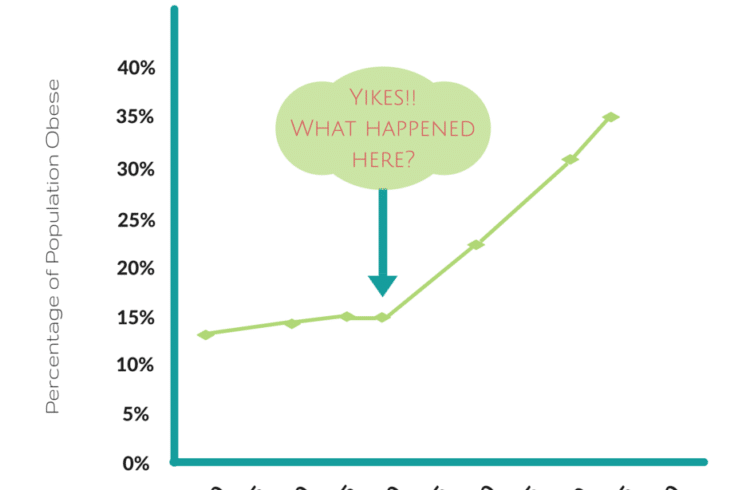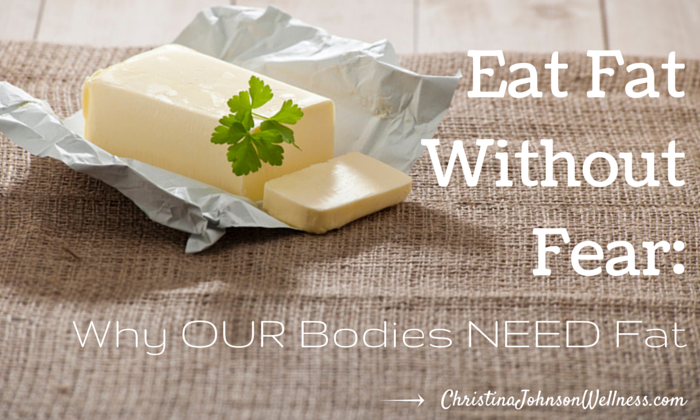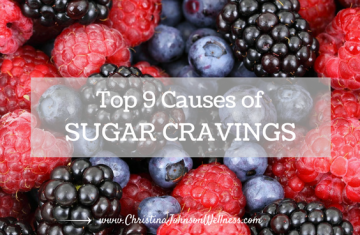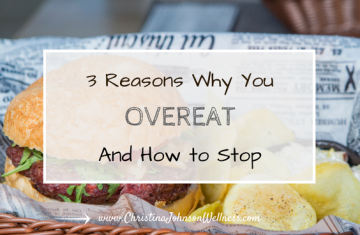Fat should be avoided…right? As a society, we are steeped in the belief that eating too much fat causes weight gain, heart disease, and a host of other problems. We have been told that we can improve our health by choosing low-fat or fat-free foods, and many of us have held firmly to this belief for years.
But is this the truth? After believing these statements for so long, it is reasonable to be slightly skeptical about the idea that fat is not the villain it has been made out to be, but that is exactly what I am about to show you. I will answer the question, “why do we need fat in our diet?”
The History of Fat
Because Americans have not always been so fat phobic, I think that a brief history lesson will help to provide perspective on where our current views about fat have come from…and I really will try to keep it brief!
If we start by looking at the diets of the early primitive and nonindustrialized people, we will find that they obviously did not consume processed low-fat foods, skim milk, or fat-free sour cream because it simply wasn’t available. They actually ate anywhere from 30-80% of their daily calories as fat. [1] Chris Kresser describes the diet of the traditional Inuit people who consumed about 90% of their calories from fat. Even more surprising is that they were relatively free from health issues such as obesity and modern degenerative diseases. [2]
If we jump ahead in time hundreds of years, we find that prior to the late 1970s, the common belief was held by Americans that eating fat and protein helps to fill you up, which prevents you from overeating. Fat phobia had not yet begun.
So how did the shift towards the popularity of low-fat foods occur? Gary Taubes’ article “What If It’s All Been a Big Fat Lie” describes the shift in much detail, so I will sum it up for you.
The low-fat theories were made public in 1977 when George McGovern published the “Dietary Goals for the United States.” In this document, he urged Americans to significantly reduce their fat intake in order to prevent the onset of many “killer diseases”. A few years later, in 1984, the National Institute of Health jumped on board and declared that all Americans (older than 2 years old) should reduce their amount of dietary fat. Despite the objections of many scientists who attempted to show that these statements were based on very little evidence, the theory of low-fat eating gained momentum quickly. This momentum was aided by the food manufacturing industry who began creating a variety of low-fat and fat-free food options. [3]
Snackwells, anyone? How many of us remember eating half a box of Snackwells cookies and thinking we were being “healthy” because there was so little fat in those cookies? Or am I the only one…? I also vividly recall eating licorice and jelly beans, happily, because they, too, were fat free!
This theory that eating fat makes you fat seems to make sense at first. Add to that the fact that the USDA’s Food Pyramid recommended consuming fats sparingly and the more recent MyPlate does not even include fats on its graphic, and it becomes easy to adopt the low-fat way of thinking.
This would be ok to accept if it seemed to be working…if so many people weren’t clearly struggling with their weight…if childhood obesity wasn’t becoming a bigger problem each year…if the rates of diabetes and other chronic diseases weren’t also increasing. Unfortunately, the graph below shows that what we are doing now isn’t working.

In fact, the Centers for Disease Control and Prevention (CDC) have been monitoring the rates of obesity for decades now, and if you look at the data illustrated above, a surprising trend emerges. From 1960 to 1980, the percentage of US adults who were obese rose from 13.4% to 15.0%, a relatively small increase during this span of 20 years.
Around 1980 is when the low-fat craze began, so the number of obese individuals should decrease over the next 20 years, right? Wrong!
From 1980 to 2000, during the height of the low-fat craze, the incidences of obesity actually rose from 15.0% to 30.9%. What a staggering increase! And it continues…from 2000 to 2008, the obesity rate increased again to 35.3%.
I will be the first to acknowledge that many other factors could be at play; however, it seems to me that eating low-fat foods is not helping people maintain a healthy weight. At the very least, I think our health deserves an open minded look at whether or not we should be eating fats.
Why Do We NEED Fat?
The first question we must look at is whether or not our bodies actually require fat in order to function. Anyone familiar with the human body will answer with a resounding yes. Fat (along with protein and carbohydrates) is one of the three macronutrients. Macronutrients are substances that are bodies require for proper functioning and survival, and they provide us with calories that can then be used for energy. All three of these macronutrients help support vital functions in our body and are needed in significant amounts.
Fat serves many functions in our bodies, some of which include:
- Healthy Cells: Fat is a building block of every cell in our body because it helps make up the cell membrane. Our cell membranes provide a barrier between what is inside and outside of our cells. In order for our cells to function optimally, the cell membrane must have structural integrity.
- Energy: Each gram of fat provides 9 calories of energy. In contrast, both protein and carbohydrates only provide 4 calories. Fats are designed to be an efficient form of energy to use in the present and also to store for future use.
- Fat Soluble Vitamins: Some essential vitamins, such as Vitamins A, D, E, and K, can only be absorbed, transported, and stored in the presence of fat. Without fat, we may become deficient in these crucial vitamins.
- Body Temperature: Fat helps regulate our body temperature so that we are not overly sensitive to hot or cold weather.
- Nervous System: Fat is an essential component of myelin, which provides insulation along nerve fibers. This insulation allows messages to be sent via nerve impulses quickly between our brain and our bodies. The myelin enables us to think and act quickly.
- Protection: Fat surrounds and protects our vital organs, such as the heart, liver, and kidneys.
- Hormones: Fat helps in the process of building and transporting hormones, especially the sex hormones.
- Bodily Processes: Fats also stimulate many chemical reactions that help to control processes like growth, immune function, reproduction, and aspects of basic metabolism.
Side Effects of a Low Fat Diet
So what happens when we don’t eat enough fat? Well, all of the above mentioned functions of fat may be negatively impacted. In addition, people who are not eating enough fat may experience some other side effects as well, such as:
- Dry and/or scaly skin
- Insatiable hunger
- Blood sugar fluctuations
- Depression, anxiety, and mood swings
- Brittle hair
- Elevated triglycerides
Don’t Fear the Fat
Despite the controversy, I am confident in the fact that eating fat supports health. I have long since given up on low-fat, processed products of any kind because they simply substitute artificial ingredients and sugar to take the place of the fat. Our bodies are designed to know how to process food in its most natural state, not after it has been altered by removing fat and adding sugar.
Yes, some people may have experienced temporary weight loss given a low-fat diet, but usually that is at the sacrifice of some other aspect of their health. And more often than not, that weight loss is not maintained in the long-term.
I do have one caveat in this discussion, though:
Not all fats are created equal.
Certain fats can actually be harmful to your health and should be avoided at all costs. However, you may be surprised by which ones are healthy and which ones are harmful! In the next post in this series, I will share with you the best sources of fats that will help improve your health.
Until then, let me know in the comments below…are you ready to throw away your low-fat food products?
Sources:
[1] Nienhiser, Jill. (2000, January 1). Characteristics of Traditional Diets [Blog post]. Retrieved from http://www.westonaprice.org/health-topics/abcs-of-nutrition/characteristics-of-traditional-diets/
[2] Kresser, Chris. (n.d.) Beyond Paleo #3, [Blog post]. Retrieved from http://chriskresser.com/beyond-paleo-3
[3] Taubes, Gary. (2002, July 7). What If It’s All Been a Big Fat Lie? The New York Times. Retrieved from http://www.nytimes.com/2002/07/07/magazine/what-if-it-s-all-been-a-big-fat-lie.html?pagewanted=1




Star
Could you inform me what theme are you utilizing on your site?
It looks good.
brentshishido
It’s a custom-made theme 🙂